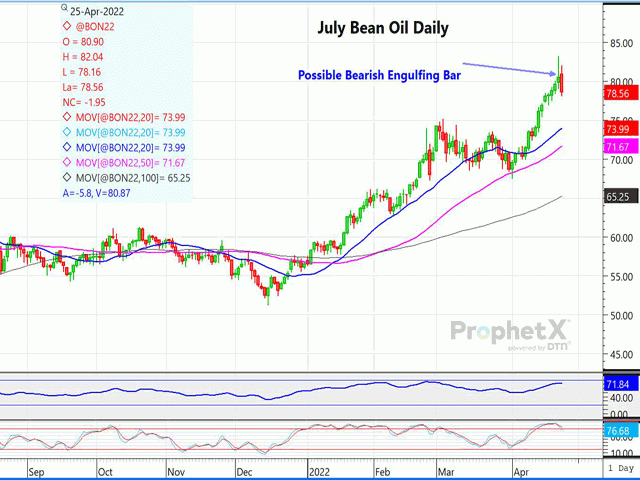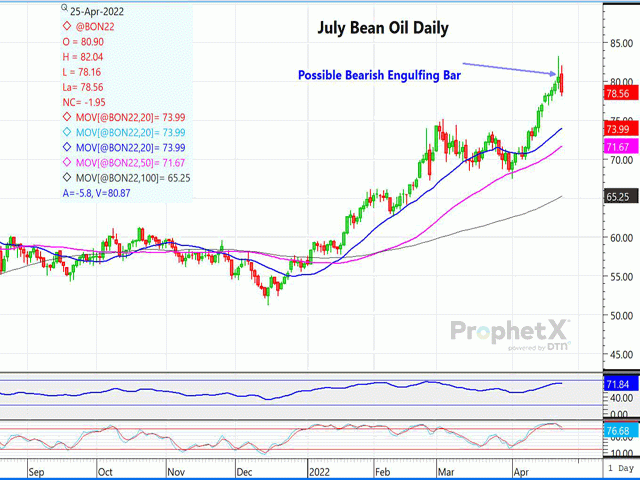Technically Speaking
July Bean Oil Futures Do an About Face Following Friday's Record High Price
Friday's surprise announcement from the Indonesian government that they would ban palm oil exports beginning April 22 to tame inflation at home sent all of the veg oil markets, including bean oil, sharply higher. July bean oil recorded a new all-time high of 83.51. However, early Monday, Indonesia clarified the ban and indicated that crude palm oil exports would not be banned, but only refined products, according to The Wall Street Journal. That, coupled with a crude oil plunge instigated by the worsening COVID situation and more lockdowns in China, sent crude and veg oils sharply lower early Monday.
Although Monday's trade is far from over, the resulting Japanese candlestick chart pattern is what is called a "bearish engulfing" bar or line -- typically a reversal signal. Assuming the market closes sharply lower, a bean oil sell signal would only be touched off if Tuesday's bean oil futures closed lower again. There is little other than this news that would suggest the world veg oil bull market has come to an end, with extremely tight supplies and the absence of Ukraine sun oil exports exacerbating the problem. However, it is something to watch. With Indonesia being the number one palm oil exporter, supplying about a third of the world's palm oil, the news is a relief to importers.
DECEMBER CORN FUTURES:New-crop December corn futures have been on a sharp upward path of late, until the past three days, when December moved lower. Although there is currently no reason to think the bull move is over, one can't ignore the negative chart action lately. China and Mexico have stepped up to buy more U.S. corn in the past few weeks, with a total of 64 million bushels (mb), both old and new crop, announced Friday; that cash demand is lending support. Last week's ethanol production moved sharply lower, a bothersome sign for bulls.
Momentum indicators on July bean oil seem to have shifted. On a fall below the 20-day moving average of $7.14 at close, we could see this weakness extend even further, perhaps as far as into the $6.75 area. Negative influences are coming from the slowing Chinese economy, lower crude oil prices, and the growing concern over rising COVID cases in China. It is hard to imagine new-crop corn going much lower, with planting challenges and an entire growing season ahead; but the technicals early Monday are flashing weakness.
P[L1] D[0x0] M[300x250] OOP[F] ADUNIT[] T[]
With heavy snows, rain and flooding in major producing states of Montana and North Dakota, and the prospect for more moisture and cold temperatures, spring wheat seeding will once again be slowed. Following weekend weather, which saw more heavy snows for western North Dakota and flooding in eastern North Dakota and northern Minnesota, it is likely hard red spring planting may not get done until after Mother's Day.
Minneapolis September is still in a bull trend and it is possible we move even higher from here. September, early Monday, came within 6 cents of the contract high. Should weather continue to not cooperate, new highs could be on the horizon.
**
Comments above are for educational purposes and are not meant to be specific trade recommendations. The buying and selling of grain and soybean futures involve substantial risk and are not suitable for everyone.
Dana Mantini can be reached at Dana.Mantini@DTN.com
Follow him on Twitter @mantini_r
(c) Copyright 2022 DTN, LLC. All rights reserved.







Comments
To comment, please Log In or Join our Community .